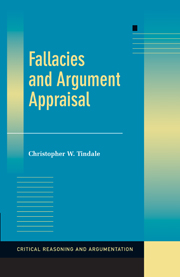Book contents
9 - CORRELATION AND CAUSE
Published online by Cambridge University Press: 05 June 2012
Summary
Correlations and Causal Reasoning
Near the end of Chapter 8, Case 8E involved the drawing of a generalization from a study that tried to establish a correlation between two things – having a busy social life and avoiding colds. Implicit in the conclusion is the causal claim that the first thing, the busy social life, caused or was a causal factor in the occurrence of the second thing, avoiding colds. The Argument from Correlation to Cause can be a reasonable argumentation scheme if it meets the correct conditions, but when these are not met, fallacious reasoning occurs.
In this chapter we will concentrate upon three types of causal reasoning that can prove problematic: (1) that which involves the concluding of a causal relation from a correlation or a mere temporal sequence, (2) reasoning that confuses the causal elements involved, and (3) that which predicts a negative causal outcome for a proposal or action, perhaps on the basis of an expected causal chain. The labels we will use for these three are post hoc reasoning, Misidentified Cause, and Slippery Slope reasoning.
Understanding causal reasoning and determining when it is fallacious are made difficult by the lack of any clear agreement on how to analyze the concept of causation. We will be able to detect cases in which something is clearly wrong with a causal argument, but more contentious cases will be a different matter.
- Type
- Chapter
- Information
- Fallacies and Argument Appraisal , pp. 173 - 193Publisher: Cambridge University PressPrint publication year: 2007



